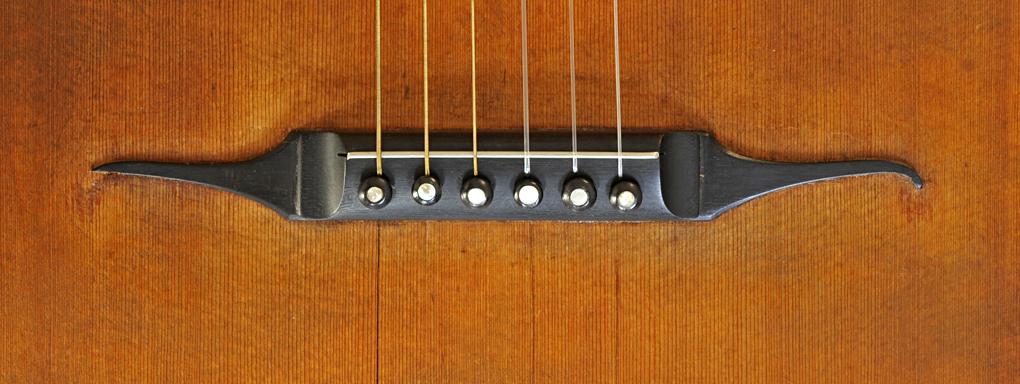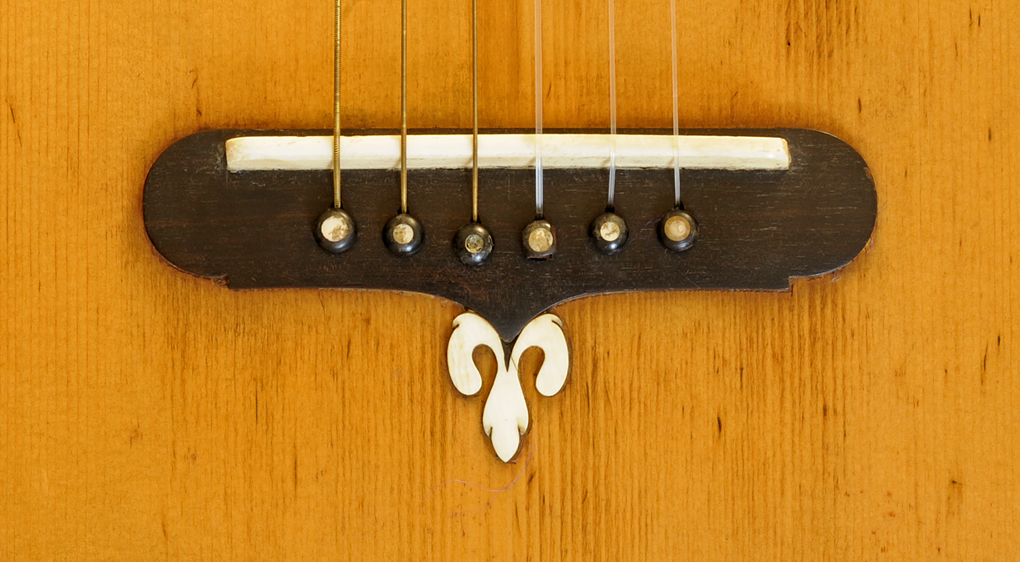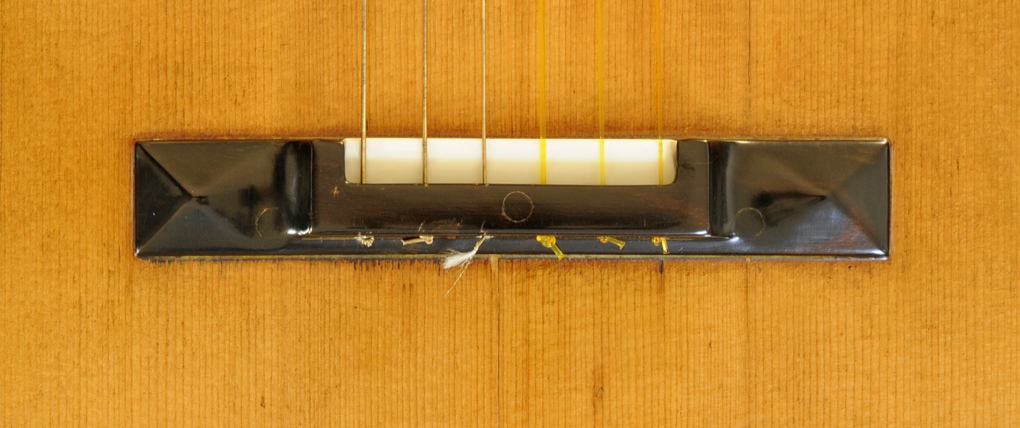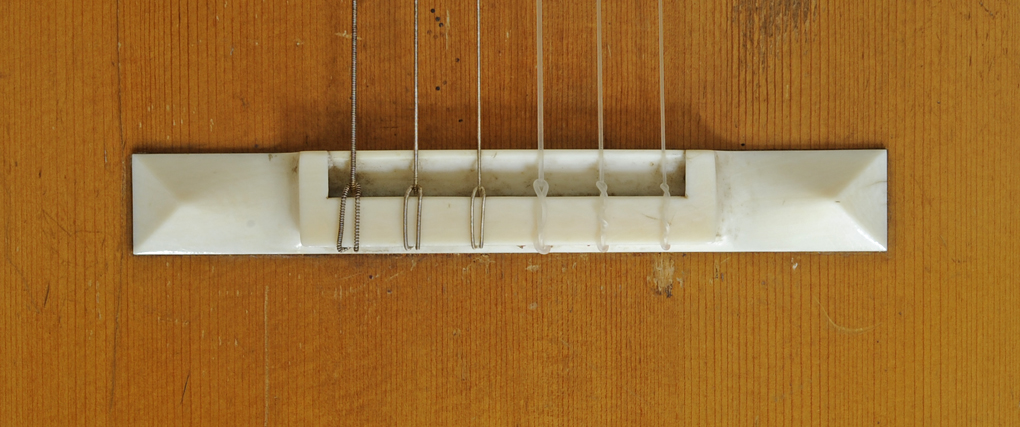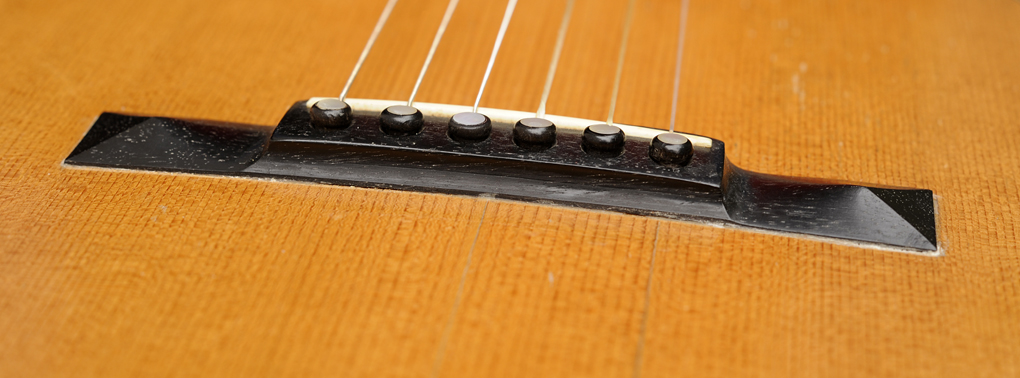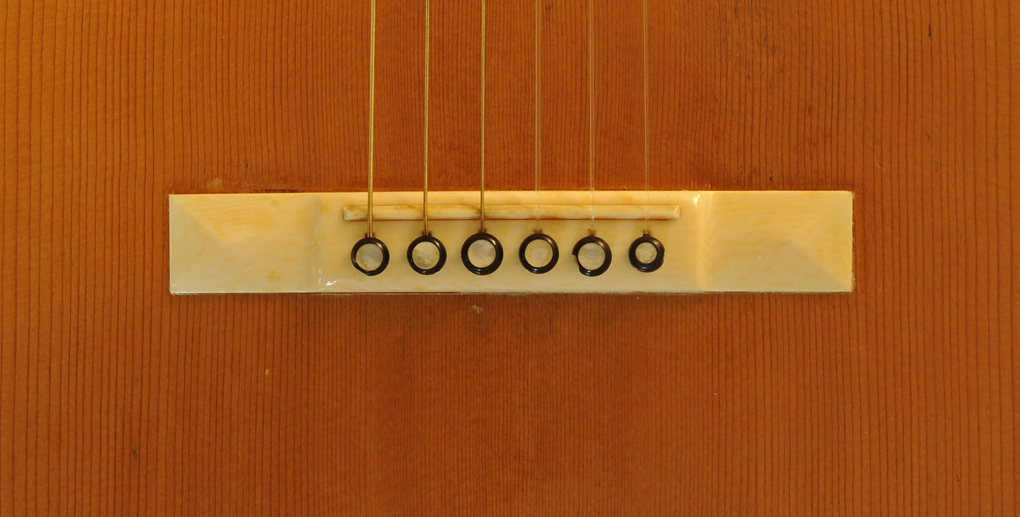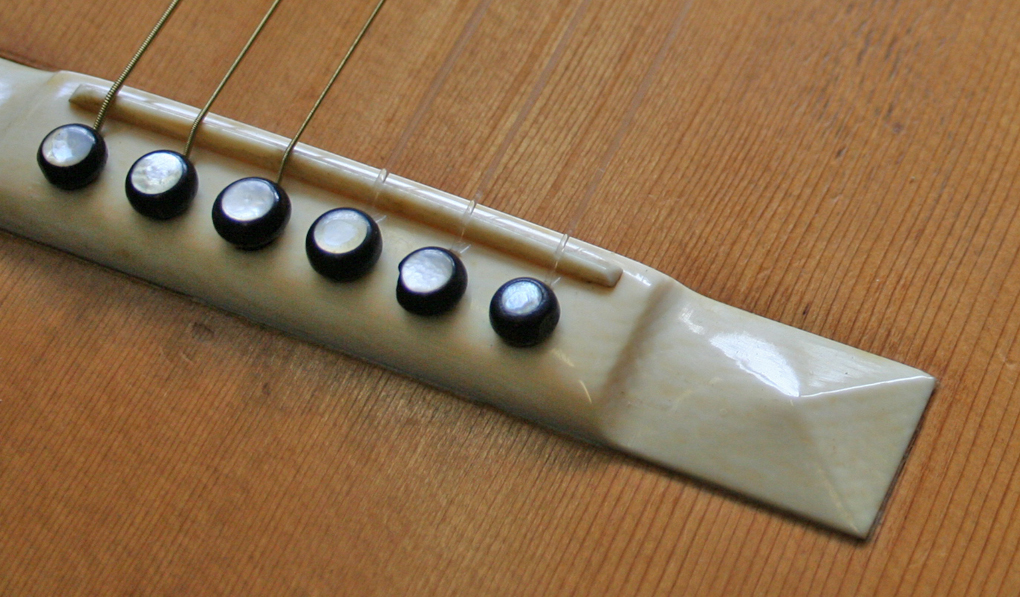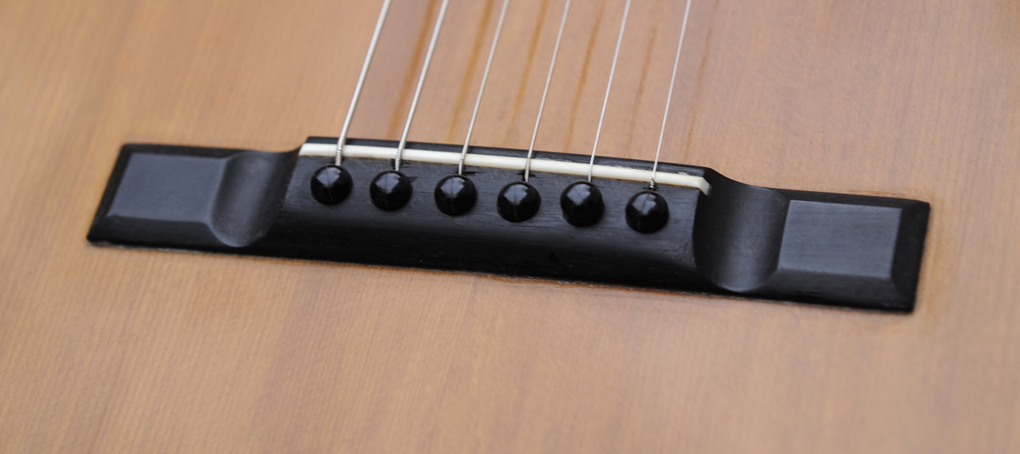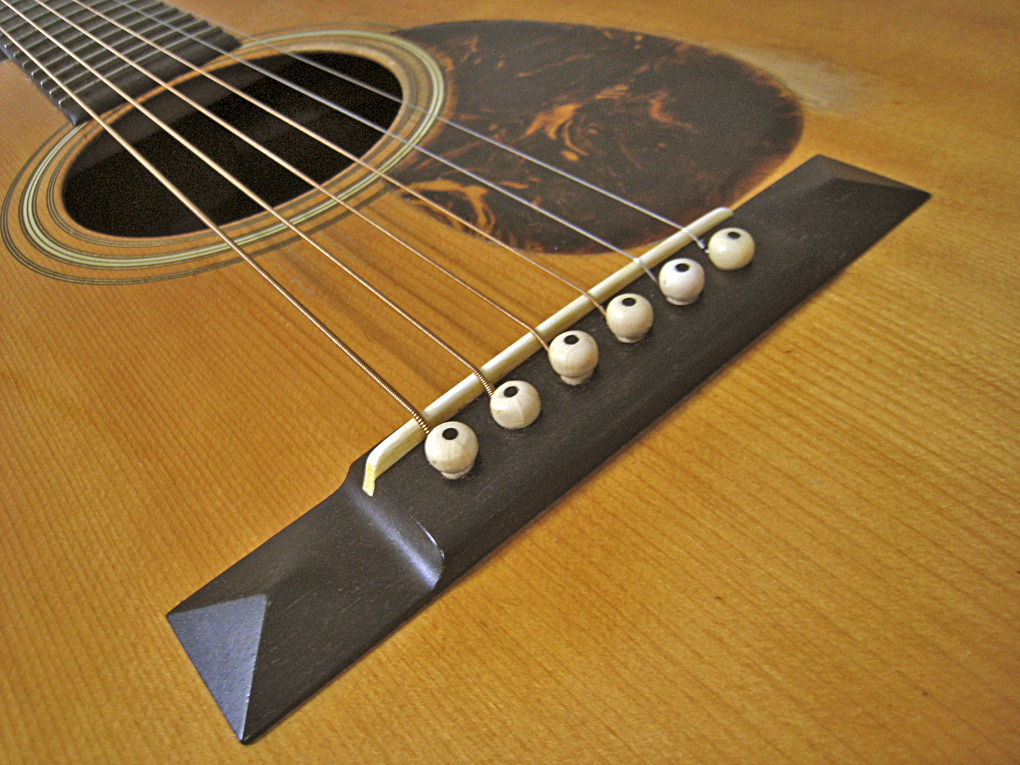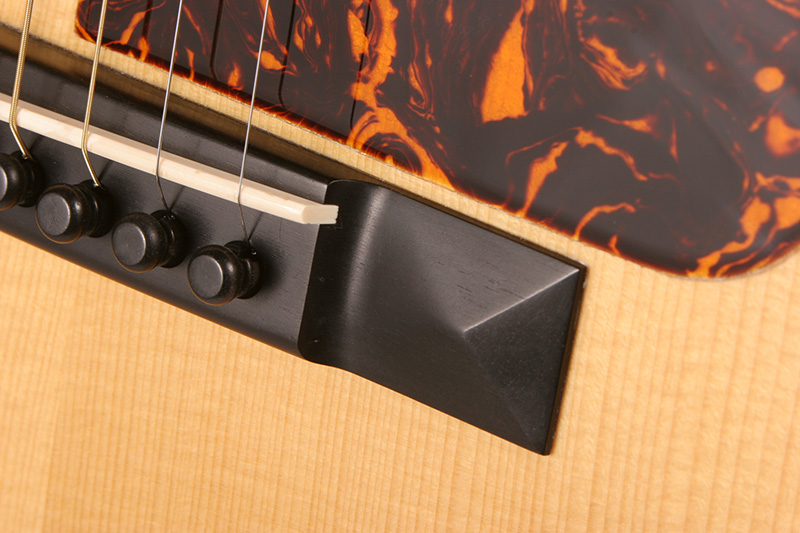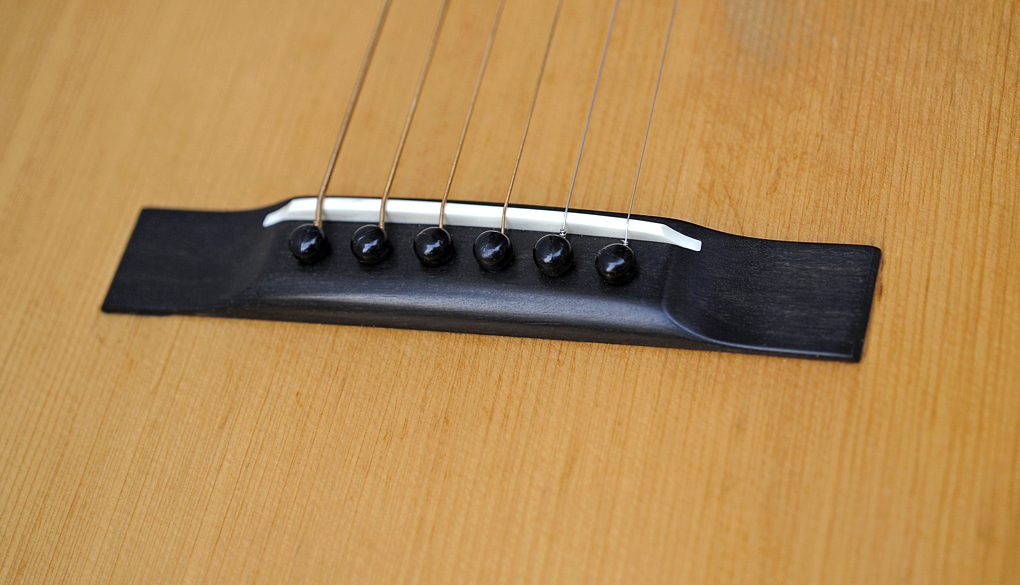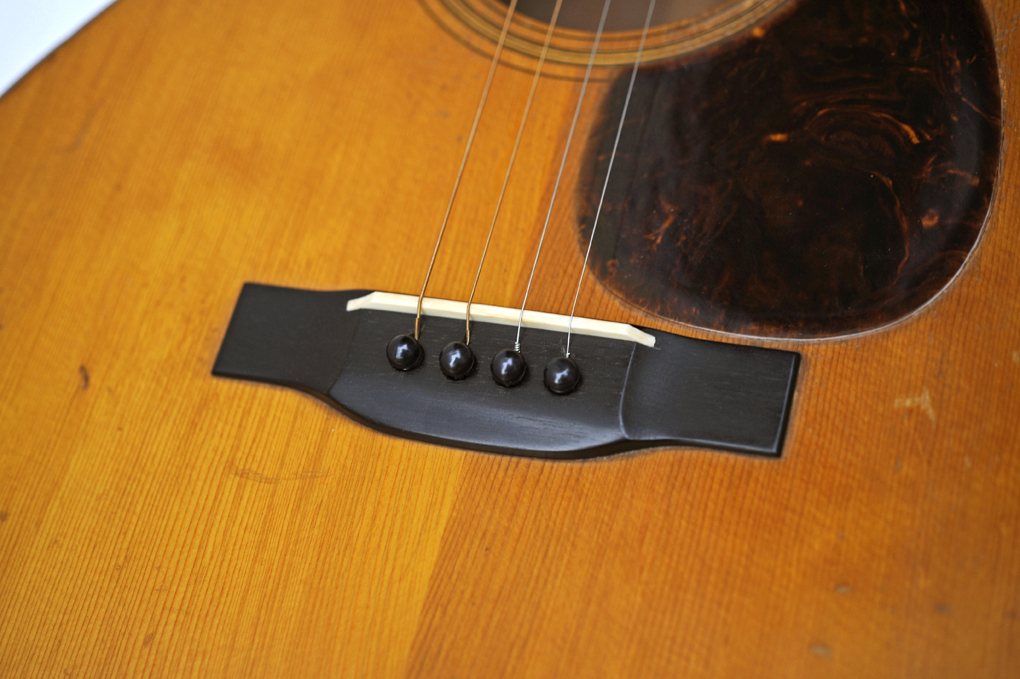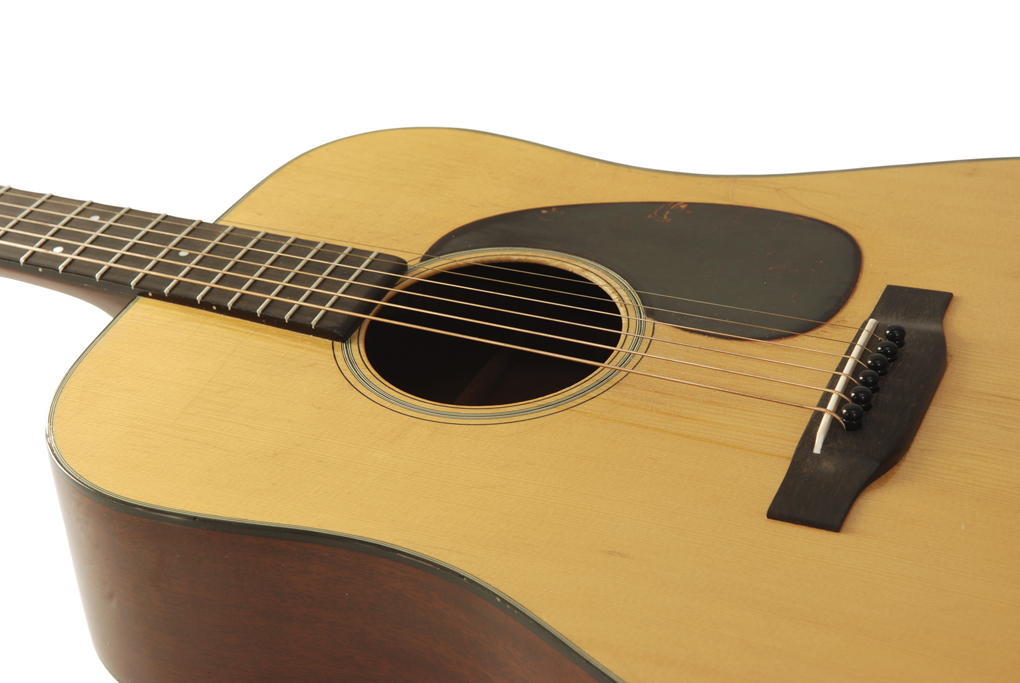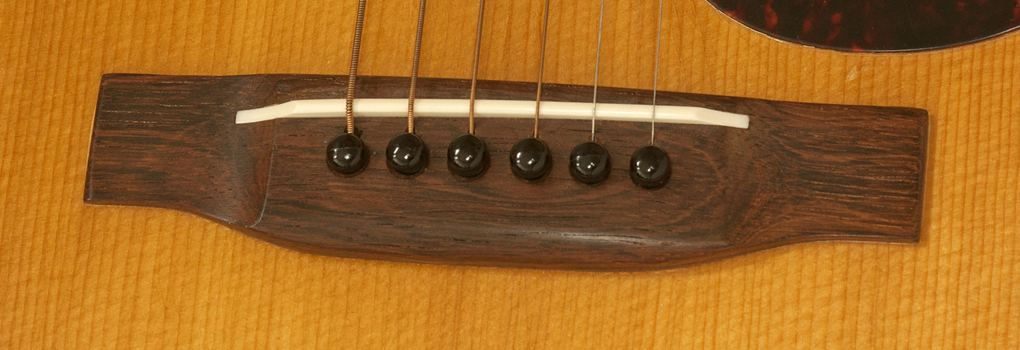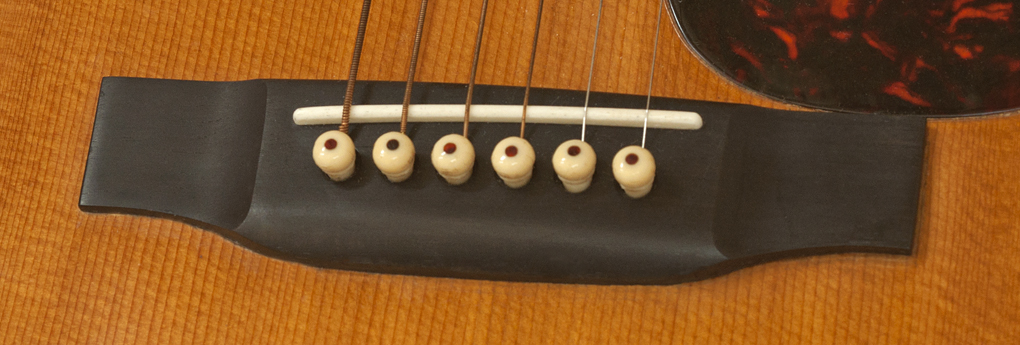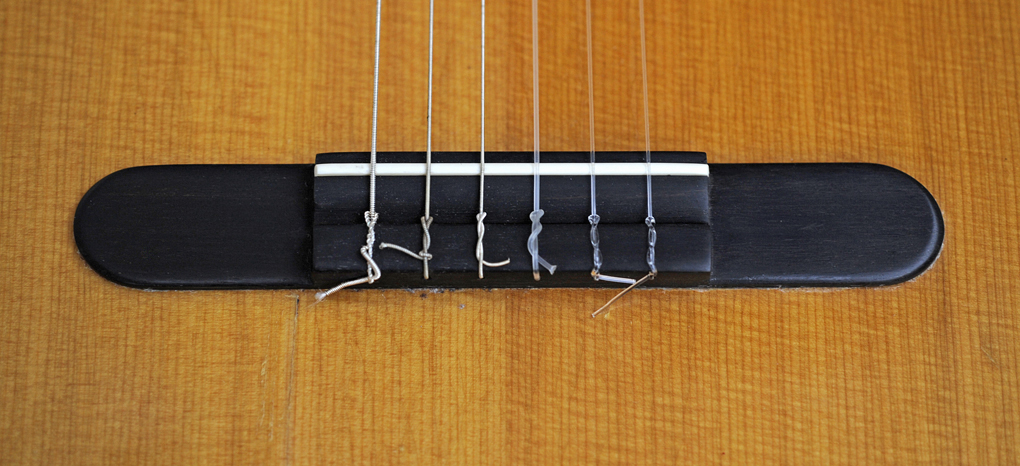BACK IN THE SADDLE AGAIN
The Evolution of Saddles on Martin Guitars
Along with the many changes in bridge designs on Martin guitars, there were changes in the saddles as well. Here we trace the evolution of saddles used by Martin and his descendants through the years.
The "moustache" bridge, appearing on early Stauffer and Martin "Stauffer Style" guitars, utilized a simple fretwire saddle.
While the pin style bridge is generally associated with steel string guitars, you can see that Martin used pin style bridges with gut strings close to 100 years before introducing steet string guitars.
A number of early Martin and Martin & Coupa guitars, such as this one, have the "badge" or "shield" style bridge, in either ebony or ivory, here seen with an added ivory pendant. Some ivory versions have a fretwire saddle similar to those on the Stauffer "moustache" bridges. Some have a simple "drop in" ivory saddle such as this.
Many early Martin and Martin & Coupa guitars have a pyramid "tie" style bridge, such as those seen on early guitars from Spain.
Early versions, such as on this Martin & Coupa, are ebony with a wide ivory saddle which curves up to form a clean edge:
This Spanish style Martin, probably slightly later, has an ivory version of the tie style pyramid bridge, still with a wide curved ivory saddle.
The earliest pin style pyramid bridge is only a slight step away from the "tie style" pyramid, with a similar "lipped" or scooped back, and the first notched "drop in" saddles.
The vestigal "lipped" or "scooped back", however, was only produced for a very short time.
These are later round back pyramid bridges in ivory, which appear until about 1919 with a notched drop in saddle:
If you look carefully, in this photo you can see the center portion of the drop in saddle which fits into the bridge, while the a short portion of the saddle at either end fits over the bridge.
It is also clear from these photos that the saddle is parallel to the front edge of the bridge, with no compensation. The saddles are generally 1/8" from the front of the bridge.
This 2 1/2 - 17 is from 1889:
Since Martin switched from a long saddle to a short saddle in 1965, most people assume that the long "through-cut" saddle pre-dated the short drop-in saddle. But as you can see, even earlier Martin bridges had short saddles before the long saddle appeared.
If you look carefully at the photograph of the ivory saddle above, you can see that the saddle is notched, with the exposed part of the saddle extending further than the shorter "drop-in" portion.
The new edition of Longworth, page 38, states that the notched saddles are "typical of pre-1910 Martins" while also saying "by the 1920's the saddle slot was open on both ends".
From what I've observed, by 1916 you start to see some saddles with a long visible top portion that extends to the ends, but that are still notched. The long through-cut saddles appear soon after.
The first of the through-cut saddles may have been on bridges purchased by Martin from Chicago in 1916.
Martin switched back to the short saddle in 1965.
During the boom years of the Hawaiian craze, as Martin was struggling to keep up with demand, the company purchased "Chicago Style" bridges supplied by Lyon & Healy, with flat, raised wings, and a long, through-cut saddle.
The ebony pyramid bridge was used until 1930, though it has been revived for models such as the new version of the Ditson 111.
This pyramid bridge is on an early 1930 OM-28.
Here is an excellent reproduction pyramid bridge on the revived Martin Ditson Style111:
Less expensive Martins had a rectangular bridge in the 1920's with plain wings rather than the more expensive pyramids.
1926 00-18
On the Style 18 the plain wing rectangular bridge repaced the pyramid in 1926.
On the Stye 21 the plain wing rectangular bridge repaced the pyramid in 1929.
In 1930, Martin developed the "belly" bridge to withstand greater tension from heavier steel strings.
Also at around the beginning of 1930, Martin began compensating the saddles, moving back the bass end of the saddle to about 3/16" from the front of the bridge.
Sometime in the mid 1930's, Martin moved the bass end of the saddle back again to 1/4" from the front of the bridge on belly bridge guitars.
The straight rectangular bridges remained at about 3/16" however.
A number of Martins from before 1930 can be seen with belly bridges, which is the cause of some confusion.
Martin still had in their factory in 1930, due to the depression, a number of unsold instruments with serial numbers dating to 1929, many of which were still unfinished, or "in the white". Martin fitted these with belly bridges before they left the factory, and additionally asked dealers to return unsold guitars which they retrofitted with belly bridges to ensure that they were string enough to hold steel strings.
Among the first of the Martins to have the belly bridge were the 18 style tenor guitars.
1931 0-18T Tenor guitar.
The belly bridges served Martin well as players moved toward the larger Dreadnaught guitars with heavier strings.
1944 Martin D-18
1962 Martin 000-18
While the Style 21 had moved to the belly bridge in 1930, Martin revived the old style plain wing rectangular bridge for the "New York" Style 21 models of the 1960's.
Martin continued to use genuine ivory for it's saddles through the 1960's.
1964 Martin 00-21NY
In 1965, Martin moved back to belly bridges with short drop in saddles. Most people, growing up with Martins of the 1960's, think of this as another new, and perhaps less desirable change, not realizing that Martin used drop in saddles for most of their existance, only using through saddles for roughly 50 of their 175 years.
While the "through" saddles were glued in, the "drop in" saddles are not, allowing one to swap out saddles easily. I know one highly regarded luthier who prefers replacing vintage through saddles with drop in saddles to allow player/owners to change to different height saddles to compensate for the changes in geometry that come with seasonal changes in hunidity. The drop in saddle slots are prepared in a way that allows one to extend them later with a router, if one wishes, to convert the bridge to accept a through saddle.
1965 Martin D-35
Martin revived the tie style bridge for it's later classical guitars such as the 000-28C of the 1960's, once again with an ivory saddle with no compensation.
1962 000-28C
STRING SPACING
It appears that Martin was moving to 2 5/16" spacing on size 2 guitars, and 2 3/8" spacing on size 1.
(all listed are pre-1867 unless otherwise noted)
Original Stauffer - moustache bridge. 2 5/16"
Hudson Street - replacement ivory pin bridge. 2 5/16"
Early fancy Spanish size 3 - ivory tie bridge. 2 7/16"
Ivory fingerboard Stauffer headstock - replacement ebony pin bridge. (I've wondered if the original was ivory pin or tie). New bridge plate. 2 1/4"
Early Spanish Martin & Coupa - ebony tie bridge with ivory inset 2 9/32"
Koa Martin & Coupa - shield shape bridge, pins in arc. 2 5/16"
LIGHT DIAMOND BACKSTRIPS/ Spanish foot
Hybrid X 1-28 2 3/8"
LIGHT DIAMOND BACKSTRIPS/ split neck blocks, old marquetry end
2-23 2 1/4"
2-24 2 5/16"
2-24 2 5/16"
2-20 2 5/16
DARK DIAMOND BACKSTRIPS
2-23 2 5/16" (solid block)
2- 21 2 5/16" (split block)
2-20 with herringbone backstrip, old marquetry end 2 5/16
1-26 with zig zag marquetry border 2 3/8"
1-21 with zig zag marquetry rosette 2 5/16"
Early 1-28 with pearl rosette 2 7/16"
Early 2-27 2 5/16"
post '67 2-27 2 5/16"
1890's 2-42 2 5/16"
vintagemartin.com
To See Robert Corwin's Classic Photography of Folk and Roots Musicians, visit:
For Information on Photography for
Exhibition, Publication, CD's, Promotion, Web Pages, Tour Books,
to Purchase Photographic Prints, or
If You Have Questions or Suggestions About This Web Site or Vintage Martin Guitars:
e-mail: Robert Corwinentire site copyright ©1998 through 2011 Robert Corwin/Photo-Arts. All rights reserved.
